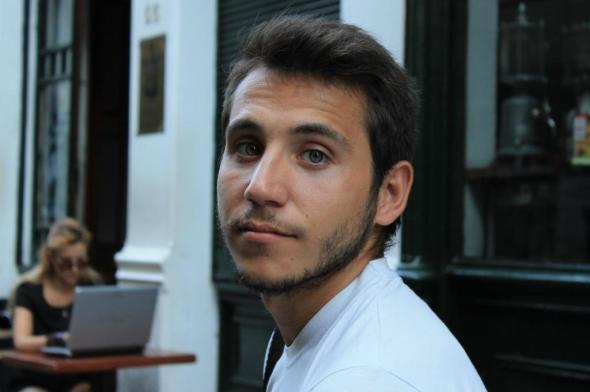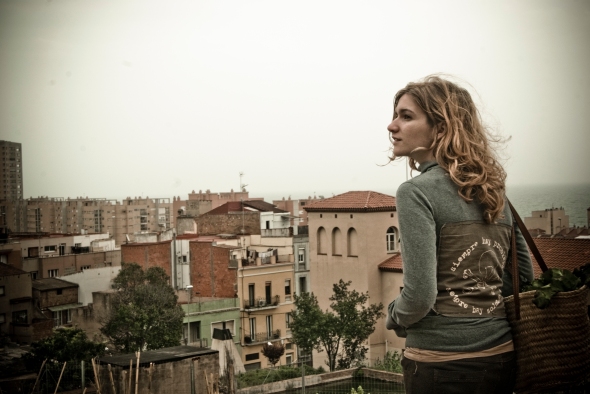The 51percent Experiment: What We Learned and Where We’re Going Now
Posted: April 15, 2013 Filed under: Blog | Tags: journalism, multi-format storytelling, multi-media, spain, the business of journalism, youth unemployment Leave a commentAbout a year ago three of us launched what we envisioned as a small multimedia experiment. The idea behind 51percent was to look at Europe’s youth unemployment crisis using some newer multimedia tools. It was a big story that was happening under our feet in Barcelona. And traditional institutions for journalism are, famously, broke, so we wanted to try to apply new business models. If we’d written or filmed the story traditionally, it was unlikely we’d have been able to sell it to a newspaper or television station for enough money to cover our costs. Even if we kept them very low.

Spain’s youth unemployment crisis is more than young people not finding work. Cultural, economic, educational and social issues add layers of complexity. But, how can we best tell this complicated story in a multi-format way? That’s the challenge we set for ourselves when we started this site a year ago. The lessons we learned mirror what many international newsrooms are also struggling with today.
Where We’ve Been
A year later, we’ve learned what we set out to learn. But most of the lessons are about journalism, not about youth unemployment in Spain. Here are a few key take-aways.
1. Keep the story very short, or very long.
To capture the story of unemployment in Spain means covering seven or so elements. After talking to a few initial sources, we parsed the story to include individual crises in Spanish education, banking (credit, basically), the local entrepreneurial culture, and a handful of other avenues to pursue.
When you do that, what becomes very clear, very fast, is that you’re asking a lot of time and attention of your audience. Too much time: Presenting a complex, broad story via multimedia is much less interesting to most people than presenting it traditionally.
Multimedia, in some senses, is critical of stories. It assumes people need lots of bells and whistles. That’s not necessarily true – and it’s a little disrespectful of the audience. If we’d made a traditional documentary film about the crisis, then the viewer would decide for him or herself whether to spend an hour viewing it. If we’d written a long article about it, you’d decide whether to curl up on a Sunday morning to read it, or not. If in either case you decide not to spend your time with our story that probably means we didn’t tell it well enough. It doesn’t mean we need to figure out how to capture your attention in some other, newer, vaguer way.
For a narrow, specific story, multimedia makes it easy to hold someone’s attention. With a story about a specific person, for example, you want to read about him or her, but maybe you also want to hear the person’s voice or see how they look. In those cases, multimedia creates a personal connection and empathy. But with a larger story like the youth unemployment crisis, where even snippets of information require a few seconds to a handful of minutes to consume and understand, multimedia is an unwieldy proposition for a reader. Should a video be four minutes long? Seven? After looking at four minutes of video, do you really want to read for twelve minutes about something else, only vaguely related? Even if the magic number was four or seven minutes for video and it was packaged with a few hundred words of text, would that do the story justice? Would readers better understand why a story like this matters, and why it was worth their time to read or watch?
Like many well-known publications experimenting with multimedia and multi-format storytelling, the verdict is still out on many of these questions.
2. Where do we read? We don’t yet know.
No one’s figured out yet what the right device is to tell a multimedia story. Your phone? Your tablet? Your laptop? Your television? To judge from audience size, the TV and the radio are still where most people get their information — including stories like the one we sought to tell. So if we were purposely avoiding the formats that most people still like, who are we hoping to reach?
3. Who gets to talk?
Part of the experiment revolved around bringing people to a discussion. But if that discussion is already happening elsewhere – on the web, on social media, in cafes, Sunday dinners — why interrupt it?
The better strategy would be to join it where it already exists, and add something new or useful. In the most fundamental sense, an investigation into the roots and meaning of the current crisis is only worthwhile if it tells most people something they didn’t already know.
Does a new form of storytelling necessarily do that better, in all cases? Is it useful for this story, specifically? After a year of looking hard at that question, we’re suspicious the answer is: Not really.
4. How do we make a living with this journalism model?
If you follow the media market, even peripherally, you know that many outlets are struggling financially. That means your average staff journalist or freelancer often struggles financially as well and worries about his or her job and where the next pay check will come from, and for how much.
We wanted to break the cycle of financial insecurity and find a different way of making a living wage doing work we love. We figured if we could create a model based on a repeatable process – i.e. find a great story, tell it in a combined package of video, text and infographics, and syndicate it on an international basis or sell it on Amazon or via a mobile app – we could find plenty of other stories to tell, right here in Barcelona or around Europe. We toyed with the idea of finding sponsors (corporate or otherwise) to front the production costs, and then offering the story for free, for exposure, to big-name, mainstream media companies in the U.S., Europe and emerging markets, like the Middle East. We tried to get individual newsrooms to chip in a small part of the costs, and in return give them some editorial control in shaping the end product to better suit their specific audiences. We briefly tried out crowdsourcing in both the U.S. and in Europe, and we did our best to build a small but loyal tribe via social media. We even talked to an app developer and started to go down that path pretty seriously.
Essentially, we needed MBA degrees without going to business school. If we wanted this project to succeed and become a model for future stories we were already thinking about, we had to think more like business people more than journalists. As full-time journalists working on this project and others, our hands were already full; learning how to manage and then actually managing demanding tasks usually overseen by operations, partnership development, product development, finance and marketing experts stretched us even thinner.
That said, apparently, there’s a whole market emerging for journalists-turned-business-people. Many others — with mixed amounts of success and failure – have set out to develop viable and sustainable business models blending traditional journalism with new storytelling techniques. Take Atavist, Byliner, the Guardian or NowThis News.
The hard truth, however, is that few media organizations are turning a significant profit from any of these experiments, no matter how sustainable and viable they originally sound on paper. That’s not to say some models won’t make it. We hope some do. For the three of us, though, the continued investment in time and resources needed to move this story forward was beyond our means. And, you don’t need a business degree to figure that out.
Spotting Trends
Part of the way we learned these lessons was by looking at the data from this website. Two things jump out.
One is that our most successful item, by far, was an essay by Albert Llado on his feelings about his own employment situation.
How do we measure success for that story? It wasn’t our most read. Our most read over the year was a short item noting a gaffe by President Mariano Rajoy, who had been spotted passing a note to an aide complaining that Spain “is not Uganda.”
Lots of people read that item — in Uganda. It was an unexpected success at reaching a conversation, but not the one we’d intended. It became part of a conversation about Spanish impressions of eastern Africa.
That was great. But not our goal. If you define “success” as adding to the discussion we’d hoped to reach – about the local youth unemployment crisis and its further-reaching societal and cultural implications — Albert’s item did that. It became part of several thousand people’s thinking and writing about the situation here.
As we analyzed Albert’s piece, we noticed a trend. Another thing that seemed to resonate with people over the past year was a short video series Lucija produced, documenting different people’s efforts to navigate their own employment crises. Some of these “diaries” were produced and edited; others were simply a person talking into our camera.
Taken together, the success of Albert and Lucija’s ideas tell us that mutlimedia’s best use might be to create not an explanatory or analytical record of the crisis, but just an archive of voices and experiences amid it. That’s not to say journalism around the crisis doesn’t matter. Do we need the details of these times investigated and explained clearly? Certainly. But do most people want to read that, regularly, for a few hours a week, in a multimedia way? Not likely.
However, would a growing record of individual experiences be valuable to the conversation? After a year, we’re inclined to say yes to that. Or at least, we can say that the personal narratives are what people have responded to most here.
Where We’re Going Now
With that in mind, a few weeks ago we decided to stop investigating the crisis in the traditional journalistic sense, and turn this space into a blank wall where people can hang their own experiences. Such places exist already. But they are dispersed, and tend to be part of personal blogs or temporary initiatives. The idea here is to put this in one place.
We’ll also organize them a little, to make things a little less chaotic. The goal is to post video or written submissions, and we’ll have to curate those somewhat – we can’t publish everything we get. But we’ll do our best to expand the conversation as broadly as this space will allow.
From there, with a submission author’s permission, we’ll look to distribute those voices abroad. The final thing we’ve learned in the past year is that any sort of familiarity with the crisis is interesting to people abroad. Events here are badly understood abroad, and voices that help make them clearer are hotly sought. We’ll collect as many as we can, and insofar as is possible, try to connect those stories and the people behind them to our own friends abroad, who seek those stories.
So, do you have story to tell us? Together we can keep the conversation going and evolve it into something that continues to put context around a complex issue, offers perspectives from voices that otherwise may not be heard and keeps us connected us to each other. These are ideals journalism always set out to achieve, regardless of what format is in fashion at the moment.
If you’d like to join us in the next phase of this project, please leave a comment below or ping us on Facebook. We’ll be in touch on how and where to best contact us.


